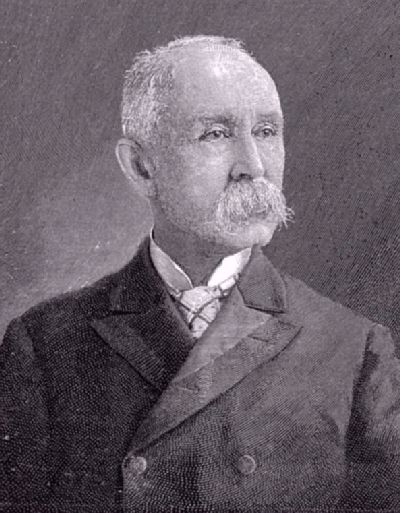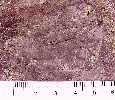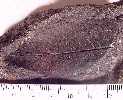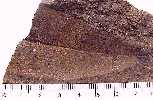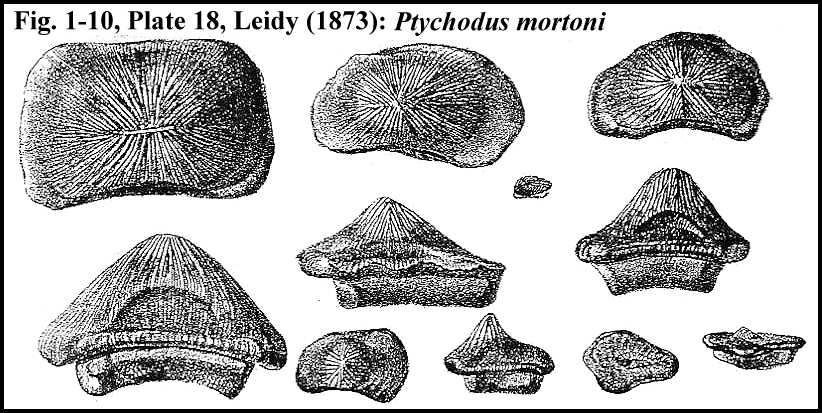While George F. Sternberg gets (and deserves) a lot of credit for his work in
the Smoky Hill Chalk of western Kansas, it was his uncle, Dr. George Miller Sternberg who
was one of the first collectors of fossils from the Dakota Sandstone, Smoky Hill Chalk and
Pierre Shale. Although Dr. Sternberg never published anything regarding the fossils he
collected, it is evident from some of his correspondence (see below) that he was intensely
interested in them, and insuring that they were properly curated and studied.
FIND
A GRAVE" MEMORIAL FOR GEORGE MILLER STERNBERG
The
Sternberg Family
Rev. Levi Sternberg
(1814-1896)
___________________________________|
|
|
George Miller Sternberg
Charles Hazelius Sternberg
(1838-1915)
(1850-1943)
|
_________________________
|__________________________
|
|
|
George Fryer Sternberg
Charles Mortram Sternberg
Levi Sternberg
(1883-1969)
(1886-1981)
(1894-1976)
|
Charles William Sternberg
(1908-1994)
|
 |
George Miller Sternberg was born in Otsego County, New York, on
June 8, 1838. He was the oldest son of Rev. Levi Sternberg and Margaret (Miller)
Sternberg. When he was 12, his father became the principal at Hartwick Seminary in
Oneonta, New York, and George was able to pursue his studies at that school for several
years. At the age of 16, he found a job teaching school to help with family
finances. After teaching for three years, he studied medicine under Dr. Horace Lathrop of
Cooperstown, New York, and attended his first lectures during the winter of
1859-1860. George Sternberg received his medical degree in the spring of 1860 at the
age of 22, and briefly practiced medicine in Elizabeth City, New Jersey until the outbreak
of the the Civil War.
George Sternberg was appointed an Assistant Surgeon in the United States
Army on May 28, 1861 and served with the Army of the Potomac. He was with General
Sykes Division the first Battle of Bull Run, and was captured by the Confederates on July
21, 1861, when he stayed behind to treat the wounded (Sternberg, M.L. 1920).
After several days, he managed to escape and returned to his command in the defense of Washington,
D.C. He later served in the Peninsular Campaign where he contracted Yellow Fever,
and was evacuated. He served the rest of the war on hospital duty in Rhode Island,
Ohio and Louisiana. For a summary of his eventful and productive medical career, you can go here. |
 |
In April, 1866, George Sternberg was promoted
to Major and assigned to Fort Harker in
central Kansas. While there he became interested in collecting fossil leaves from
the Dakota Sandstone (Late Cretaceous) Formation. He also acquired land two and a
half miles from Fort Harker and began ranching. In June of 1867, there was a cholera
outbreak at the Fort. Dr. Sternberg's wife, Louisa, was one of the first civilians
to become sick and die. Thirty-one soldiers died of cholera between June 28 and
August 1. In December, 1867, George Sternberg was reassigned to Fort Riley,
Kansas, and participated in several campaigns against the Indians along the Arkansas River
during 1868. His two younger brothers , Charles H. and Edward moved to
his ranch from Iowa and later, his father, Levi Sternberg, and the rest of the Sternberg family moved
to Kansas to live on his ranch. There his younger brother, Charles Hazelius Sternberg, also began collecting fossils.
In December, 1868, Dr. Sternberg was reassigned to duty with Major General Sheridan's command on the
North Canadian River. He was later ordered to duty at Fort Riley, Kansas, and on June 23,
1870, was assigned to duty at Governor's Island, New York Harbor. During those four years
between April, 1866, and June, 1870, while working as an Army doctor, treating epidemics
and accompanying military campaigns, George Miller Sternberg collected a number of fossils
from the Dakota Sandstone Formation, the Smoky Hill Chalk Member of the Niobrara Chalk
Formation, and the Pierre Shale Formation. By my rough count, he has at least 34
mosasaur specimens in the United States National Museum
(Smithsonian).
LEFT: Doctor George M. Sternberg, 1869 RIGHT: A sign commemorating the work
of Dr. G. M. Sternberg at Fort Harker. |
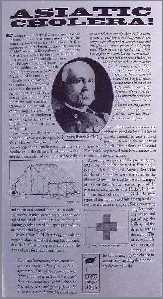 |
It appears that George M. Sternberg was more interested in collecting fossils
than studying them. While he published many medical papers, he apparently did not
write about his fossil collecting, except in his personal notes, for instance, circa
1867 ("The bluffs north and east of the fort (Fort Harker) are composed of a recent
red sandstone [the Dakota Sandstone] which contains the impressions of the leaves of trees
of existing species (oak, ash, willow, etc.)" (Sternberg, 1920, p. 12; note
that this was originally written by G.M Sternberg in his cholera report in
1867). Here is
a recent picture of the Fort Harker
Guardhouse, built from blocks of native Dakota Sandstone that were quarried from
exposures in the vicinity.
In his biography (Sternberg, M.L. 1920, p. 14), his wife wrote: "His
interest in gathering undescribed fossils and other animal remains resulted in
frequent chidings by other officers lest he should be picked off by the Indians
while securing these specimens. Some of his specimens were forwarded to Prof.
Joseph Leidy, of Philadelphia, who described them in his report on "The
Vertebrates of the West." The Indian crania, skulls of animals and birds,
and fossil shells were sent to the Army Medical Museum and were acknowledged
"to have been received in good order, being very carefully
packed.""
He certainly communicated with the
scientists of his time, including Joseph Henry (1797-1878, head of the
Smithsonian from its opening in 1846 to 1878), Spencer Baird (1823-1887, asst. head of the
Smithsonian from 1850 until Henry's death, when he became head), and John Newberry
(1822-1892, Columbia University specialist in late Paleozoic vertebrates and Mesozoic
plants. There was almost immediate interest by several vertebrate paleontologists of the
day (Agassiz, Newberry, and Leidy (who eventually published on them)) in G. M. Sternberg's
Kansas fossils, as soon as they reached Washington, D.C. (Earl Manning, 2001, pers.
comm.). A webpage regarding a collection of his papers at the National Library of Medicine
is located here.
At the first meeting (1868) of the State Natural History Society (now the Kansas Academy
of Science) in 1868, G. M. Sternberg was elected an honorary member (Nelson, 1996).
From Fort Harker, Dr. Sternberg moved further west and began collecting
fossils in the Smoky Hill Chalk.
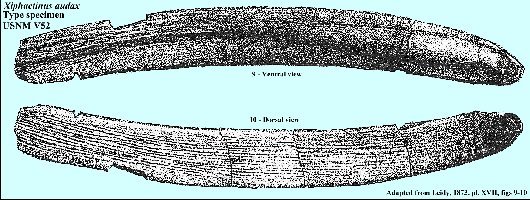
|
LEFT: While the name Xiphactinus
has been around since 1870, there has been considerable confusion over which name is
actually correct: Xiphactinus audax Leidy, 1870 or Portheus molossus Cope, 1872. Joseph
Leidy named the fish from a fragment of a pectoral fin (LEFT) which was donated to the
Smithsonian by Dr. George M. Sternberg more than a year before E. D. Cope gave the name of
Portheus molossus to a collection of several nearly complete specimens found near
Fort Wallace. Leidy won by virtue of being first to publish, but Cope's name was more
popular and is still in use (incorrectly) in many collections of Cretaceous fish.
Recent photo by Susan Liebl HERE |
According to his wife, (Sternberg, 1920; p. 14), "during the marches that
he made with the command, he became interested in the geological conformation of the
country, made close observations and copious notes, and collected much material. His
interest in gathering undescribed fossils and other animal remains resulted in frequent
chidings by other officers lest he should be picked off by the Indians while securing
these specimens. Some of his specimens were forwarded to Prof. Joseph Leidy, of Philadelphia, who
described them in his report on "The Vertebrates of the West." The ... skulls of
animals and birds, and fossil shells were sent to the Army Medical Museum and were
acknowledged "to have been received in good order, being very carefully packed."
Many of the specimens that he collected from the Smoky Hill Chalk were sent to
the U.S. Army Medical Museum and traveled from there to the U.S. National Museum. During
the summer and fall of 1867, Dr. John L.
LeConte was part of a group surveying for the Union Pacific Railroad. One of the first
localities mentioned in his survey report (LeConte, 1868:pp. 7-8) was Fort
Harker. He reported that a collection of fossil leaves had been "obtained
in November, 1866" (possibly from G. M. Sternberg, who was at Fort Harker at the
time) and had been examined by Leo Lesquereux . LeConte
added that he had "procured" others while at Fort Harker and sent them to
Lesquereux. In his 1868 paper on fossil plants, Lesquereux credited LeConte and F. V. Hayden for the
materials he examined, and wrote that all the specimens had "come from the Cretaceous
formation north of Fort Ellsworth, Nebraska, or its vicinity" (Fort Ellsworth was
renamed Fort Harker in November, 1866... the site is now in the town of Kanopolis, in
Ellsworth County). Joseph Leidy (1873) generously credited Dr. George M.
Sternberg with finding a number of the fossils that he examined and described for his
"Report of the United States Geological Survey of the Territories". Sternberg's
donations included a fragmentary pectoral fin of
Xiphactinus audax Leidy 1870, one of the first vertebrate specimens to be
described from the Smoky Hill Chalk Member. In a brief history of fossil collecting in
the Niobrara Chalk, Samuel Williston (1898; p. 32) wrote, "Other specimens were
later obtained by Drs. J. H. Janeway and George Sternberg in the vicinity of Forts Hays
and Wallace, and by Mr. Webb, of Topeka." Dr. John Janeway was the military surgeon at Fort Hays while
G. M. Sternberg was serving with Sheridan's command further west in Kansas, between Fort
Hays and Fort Wallace. In his biography, Martha Sternberg (1920; p. 52) wrote that,
"In time Dr. Sternberg sent specimens to Professor Cope of Philadelphia and other
scientists for description and classification." Sternberg later sent fossils from
Washington state while assigned there in 1876. (See Kansas
1872 map HERE)
In 1878, E. D. Cope credited Dr. Sternberg with the discovery of a giant deer (Cervus
fortis sp. nov.) from the Loop Fork Beds in Oregon. Cope noted that
"...George M. Sternberg, M.D., U.S.A. [was] already well-known for his interesting
discoveries in the cretaceous formation of Kansas."
G. M. Sternberg (along with John LeConte) was also one of the first to collect
sharks teeth from the Smoky Hill Chalk and was credited by Leidy (1873) with several
specimens that he illustrated. In regard to the Ptychodus teeth, Leidy
noted that. "The Smithsonian Institution has submitted to my examination a collection
of fourteen specimens of teeth obtained by Dr. George M. Sternberg, United States Army,
from the banks of Chalk Bluff Creek, a branch of Smoky Hill River, about sixty miles east
of Fort Wallace, Kansas. The specimens were found in two parcels, each together, as if
pertaining to two individuals." The figures published by Leidy are shown below:
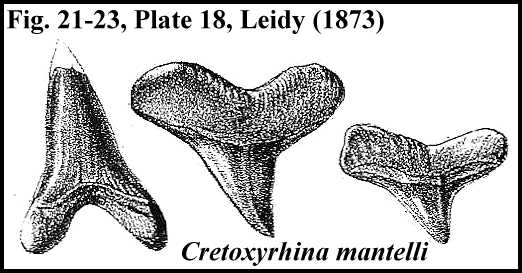 |
LEFT: Cretoxyrhina mantelli teeth
collected by Dr. George M. Sternberg (Smithsonian Collection). See
other Kansas sharks here. |
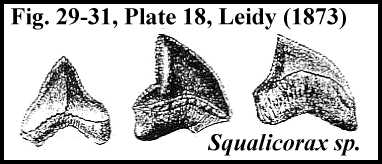 |
LEFT: A small collection of Squalicorax teeth: left tooth
- S. falcatus; the two teeth on the right are either S. kaupi or
possibly S. pristodontus. (collected by Dr. George M. Sternberg) - (Smithsonian
Collection) |
Shown below are several of the G. M. Sternberg specimens in the United States
National Museum (Smithsonian) in Washington, D.C.:
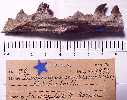 |
Two pictures of a piece of a Platecarpus
pterygoid bone (USNM 9439). The blue star indicates that this specimen was figured
in a publication. RIGHT: In this case,
it was Figure 12 on Plate 34, pages 277-278 of: Leidy, J., 1873. Contributions to the
extinct vertebrate fauna of the western interior territories. Rept., U.S. Geol. Surv.
Terr. (Hayden) 1:358 pp., 37 pls.. Dr. Sternberg's original specimen number is in the
upper left (76). |
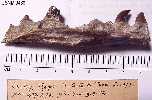 |
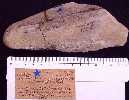 |
LEFT: USNM 3894 - The premaxilla of a large Tylosaurus
proriger (also figured in Leidy, 1873). The letters
"A. M. M." show up faintly on this and other G. M. Sternberg specimens that were
originally sent to the "Army Medical Museum"; USA stands for United States
Army. This material was re-identified by Russell (1967) as Tylosaurus
nepaeolicus and is the first known example of that species to be found. RIGHT:
A limb bone (ulna) from a Platecarpus (USNM 50). Contrary to the
information on the upper card, a drawing of this specimen was published in Leidy (1873;
pl. 36, fig.13). |
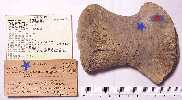 |
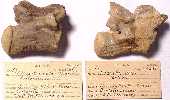 |
These four Clidastes velox (now C.
propython) cervical vertebrae (anterior end is to the right) from a single
specimen (AMM 9331). It's not clear why they that were given four different catalog
numbers (USNM 58, 59, 61, 68) when curated into the United States National Museum
collection . |
 |
 |
LEFT: Three crushed Platecarpus vertebrae
(USNM 62) that bear G. M. Sternberg's name. These are part of a larger collection of
vertebrae from a single specimen that was figured in Leidy (1873). RIGHT: A single
large Tylosaurus proriger vertebra (USNM 45), with the markings: AMM
9232 Kansas Dr. Sternberg USA |
 |
According to Craig (1998, p.200), Sternberg was fascinated with the
"natural beauty of the undeveloped western Kansas with its abundance of flora and
fauna." "His inherent scientific curiosity led him far afield to gather fossils,
animal remains, and Indian artifacts, which he dutifully sent to the Army Medical Museum.
So far afield would he go, in fact, that officers in the command feared he might
fall prey to the Indians on his excursions. Apparently unconcerned for his safety,
Sternberg continued his explorations throughout the campaign." The text of a letter
written by Sternberg in 1868 is shown below (From the Smithsonian Institution Archives,
provided by Earl Manning):
Headquarters, Department of the Upper Arkansas (In the
field)
Office of the Chief Medical Officer
Camp near Fort Dodge, Kansas
November 6th, 1868Bvt.
Lieut. Col. Otis, Asst. Surgeon, U.S.A., Curator of the Army Medical Museum, Washington,
D.C.
Doctor,
I have stored at Fort Wallace, Kas., in charge of
Lieut. Wood, 5th U.S. Cav., four boxes of fossils from the cretaceous beds of Western
Kansas. I have had unusual advantages during the past summer for making a collection from
these beds, and as it was nearly all new and unexplored ground, I have succeeded in
obtaining a very valuable collection.
The collection consists principally of teeth, jaws,
vertebrae, etc. of numerous species of saurians and fish. About two months since I
met Proff. Agassiz at Fort Hays and told him of my collection, presenting him with a few
specimens. He was much delighted with the specimens I gave him and expressed an intention
of going to Washington to see my collection as soon as it should arrive there. I told him
that you would doubtless be glad to have him assist you in identifying specimens of known
species and in describing new species. I also promised him that in case he rendered you
such assistance, I would request you present him with duplicates of specimens, where they
could be spared from the collection. My boxes were packed hastily, with the intention of
carefully repacking and labeling them when I should have more leisure, but I was
obliged to leave them at Fort Wallace for want of transportation and have not since had an
opportunity to obtain them and may not have for a long time to come. I therefore write to
you leaving it optional with you whether to send for them yourself, or take the chances of
my being able to repack and forward them at some future time. If you decide to send for
them now, you had better write to Asst. Surgeon Turner, Post
Surgeon at Fort Wallace, requesting him to obtain them from Lieut. Wood and forward
them to you. I fear that no one but myself can unpack and arrange the specimens
without getting them in confusion and it would add very much to their scientific value if
I could have an opportunity to describe the location and position in which the different
specimens were found. It has occurred to me that the Surgeon General might be
willing to order me to Washington to assist in unpacking and arranging the collections.
Please mention the matter to the Surgeon General or to his Assistant Surgeon General. I
have never seen the Army Medical Museum and it would be a great pleasure for me to see it.
I have now been in the field for over six months and have had a pretty hard time of it
ever since I came to this Department. I think that in the course of two or three
months my services could be spared for a time.
Very respectfully, your obedient servant, signed, G. M. Sternberg, Bvt. Major
and Asst. Surgeon, U.S.A., Chief Medical Officer |
Katherine Rogers (1991, p. 23) notes in her book on the Sternberg family that
Dr. Sternberg's "interest in fossils and strange, old bones reached from one fort to
another, and one day he received a collection of fossils from Dr. Theophilus Turner at
Fort Wallace, near the Kansas-Colorado border. (Editor's note: Turner had discovered the type specimen of Elasmosaurus
platyurus in 1867 near Fort Wallace and sent three of the vertebrae to E. D. Cope
by way of LeConte. It is unknown what other material he may have collected before he
died unexpectedly on July 27, 1869) Sternberg bided his time until he had occasion
to go to Washington, then took the fossils to paleontologists in Philadelphia
[Cope?]."
Later (1991, p. 129) she says that Charles
H. Sternberg and his son, George F. Sternberg went to Washington D.C. in 1912, to
visit Dr. Sternberg [ten years after his retirement from the Army and the post of
Surgeon General of the Army]. Apparently the two brothers had not seen each other in
many years. "Charles felt that at last he was in a position to let his brother
know he'd made a success of life as a fossil hunter, and attributed no small part of that
success to his brother's continued encouragement and assistance. ... Charles gratefully
recalled that it was his brother who had first alerted O. C. Marsh, Joseph Leidy and other
paleontologists to the existence of Kansas' vast fossil beds, worthy of exploration"
(p. 130). Rogers also noted that "Charles' son, George F. Sternberg, was his
uncle's namesake, and so appreciative was the old doctor of this gesture on the part of
his brother, that he remembered young George quite generously in his will." A copy of
George Sternberg's will is part of the Sternberg papers at the Forsyth Library at the Fort Hays State University, Hays, Kansas.
More to come: The early paleontological work of George M. Sternberg is the
subject of a paper in preparation by Earl Manning and Mike Everhart.
Web pages about early workers in Kansas paleontology (in
order of year of birth):
Louis Agassiz (1807-1873)
- Swiss born
scientist and paleontologist, one of the founders of the Museum of Comparative Zoology at Harvard.
E. D. Cope
(1840-1897) - Described the first Cretaceous vertebrate from
Kansas in 1868; named most of the mosasaurs, marine turtles and fish from the Smoky
Hill Chalk Member. (Picture) (Picture)
F. V. Hayden
(1829-1887) - A geologist, who with F. B. Meek, named the Niobrara Formation. Another F.
V. Hayden Page
John H. Janeway (?-?) - Little is known about Dr.
John H. Janeway, save that Williston and Cope give him credit for collecting fossils in
Western Kansas. Cope (1875, p. 17-18) wrote of him, "Fragments of fish-vertebrae of
the Anogmius type were also found hereby Dr. J. H. Janeway, post-surgeon. These
were exposed in the yellow bed. Several miles east of the post, Dr. Janeway pointed out to
me an immense accumulation of Inoceramus problematicus in the blue stratum."
Joseph Leidy
(1823-1891) - The Father of American vertebrate paleontology (Picture); described many Kansas fossils; Another Joseph Leidy Page
John
L. LeConte 1825-1883 - Entomologist; one of the first to publish a description of the
geology of western Kansas (1868).
Leo Lesquereux
(1806-1889) - The Father of American paleobotany; described many plants from leaves in the
early Cretaceous Dakota Sandstone near Fort Harker, especially those collected by C. H.
Sternberg. Another good page is here: Leo Lesquereux (1806-1889)
paleobotanist
O. C. Marsh
(1831-1899); Organizer of the Yale College Scientific Expeditions.... sent teams of
collectors to Kansas 1870-1876; Another Marsh Page Here
includes information on the expeditions. (Picture)
Handel T. Martin
(1862-1931) - Student of Williston, Curator at the University of Kansas Museum of Natural
History
Benjamin F. Mudge (1817-1879) - First
State Geologist of Kansas, one of the first to collect fossil leaves, tracks and
invertebrates; one of first to collect fossils in the Smoky Hill Chalk; discovered Ichthyornis;
collected for O. C. Marsh for several years.
Charles H. Sternberg (1850-1943) - Brother of
George Miller Sternberg; major collector of fossils from the Smoky Hill Chalk and
elsewhere. (Picture)
George F. Sternberg ( 1883-1969) - Son of C. H. Sternberg; collected in Kansas,
Texas, and Canada; Dug and prepared the famous "Fish in a
Fish"
George Miller Sternberg (1838-1915) - This page; soldier, medical doctor,
fossil collector; older brother of Charles H. Sternberg.
Theophilus H. Turner (1841-1869) - Post surgeon
at Fort Wallace - Discovered and dug the remains of Elasmosaurus
platyurus in 1867.
Samuel Wendell
Williston (1851-1918); Paleontologist, entomologist, medical doctor; Reviewed the
vertebrates from the chalk in 1898; began the study of the biostratigraphy of the chalk. (Picture)
References: (See Kansas 1872 map HERE)
Almy, K. J. 1987. Thof’s Dragon and the letters of Capt. Theophilus
Turner, M.D., U.S. Army, Kansas History Magazine, 10(3):170-200.
Anonymous. 1899. Sketch of George M. Sternberg. Popular Science Monthly
41(1):116-121, with portrait.
Cope, E.D. 1875. The Vertebrata of the Cretaceous formations of the West.
Report, U. S. Geol. Surv. Terr. (Hayden). 2:302 pp., 57 pls.
Cope, E.D. 1878. Descriptions of new Vertebrata from the
upper Tertiary formations of the West. Proc. Amer. Phil. Soc. 17(100):219-231. (mention of
Dr. George Sternberg's discoveries) <EM>
Craig, S.C. 1998. Medicine for the military: George M. Sternberg on the
Kansas Plains, 1866-1870. Kansas History 21(3):188-206.
Everhart, M.J. 2005. Oceans of Kansas
- A Natural History of the Western Interior Sea. Indiana University Press,
322 pp.
LeConte, J. L. 1868. Notes on the geology of the survey for the extension
of the Union Pacific Railway, E. D., from the Smoky Hill River,
Kansas, to the Rio Grande. Review Printing House, Philadelphia, 76 p. with folded map.
Leidy, J. 1873. Contributions to the extinct vertebrate fauna of the
western interior territories. Rept., U.S. Geol. Surv. Terr. (Hayden) 1:358 pp., 37 pls.
Lesquereux, L. 1868. On some Cretaceous fossil plants from Nebraska. American
Journal of Science, Series 2, 46(136):91-105. (for July)
Nelson, M.E. 1996. Geological exploration of Kansas as recorded by the
Transactions of the Kansas Academy of Science (1868-1879). Kansas Acad. Sci. Trans.
99(3-4):115-123.
Peterson, J.M. 1987. Science in Kansas: The early years, 1804-1875, Kansas
History Magazine, 10(3):201-240.
Rogers, K. 1991. A dinosaur dynasty: The Sternberg fossil hunters,
Mountain Press Publishing Company, 288 pages.
Sternberg, C.H. 1909. The life of a fossil hunter. Henry Holt and Co.
286 pp. (re-published 1990 by the Indiana University Press).
Sternberg, G.M. 1867. Report
on epidemic cholera and yellow fever in the Army of the United States during the
year 1867. Surgeon-General's Office, Circular No.1, pp.29-30.
Sternberg, M.L. 1920. George Miller Sternberg; A biography. American
Medical Association., Chicago. i-ix, 331 pp., 10 pls.
Williston, S.W. 1898. Addenda to Part I.
The University Geological Survey of Kansas, 4:28-32.
Credits: I thank Earl Manning for the inspiration to produce this webpage,
his advice on historical issues, and many useful references.

